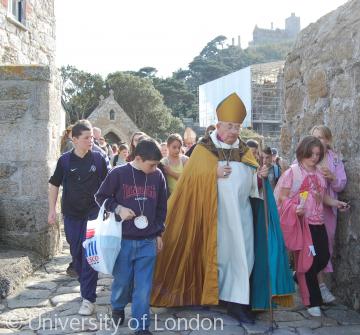Religious Figures
 The Rt Revd William Ind, Bishop of Truro leads a group of school children across the causeway at St Michael's Mount to mark the 40th anniversary of hi
The Rt Revd William Ind, Bishop of Truro leads a group of school children across the causeway at St Michael's Mount to mark the 40th anniversary of hiThe church has produced many noted people. Parishes remember a good priest although he served centuries ago, sadly some remember scandalous ones and some religious figures are known less for their piety as for their successful careers. Legends of hermits and anchorites have come down the centuries but also the lives and works of men and women like Roger Bacon from Somerset or Dame Julian of Norwich.
The great players in the reformation era have their place in history: Cardinal Wolsey at Hampton Court, Sir Thomas More at Chelsea and Thomas Cromwell from Putney. So do the many martyrs on both sides of the religious divide still remembered today like the Protestant martyrs at Oxford or Margaret Clitherow at York.
The 17th and 18th centuries saw the rise of prominent dissenters like Robert Fox and John Wesley but local preachers were also important in the establishment of congregations. Other local religious groups were established such as Nicholas Ferrar's community at Little Gidding, Cambridgeshire or the strange Agapemone at Spaxton, Somerset begun by the Revd Henry Prince.
Some religious figures are known for their charitable work like Elizabeth Fry at Newgate prison or the Revd Dick Sheppard at St Martin in the Fields, London.









